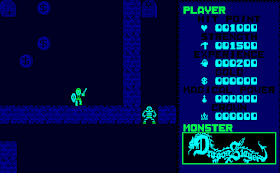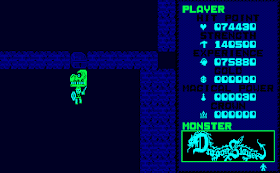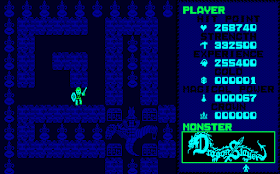 |
| This dead cleric might be a good candidate for a "Resurrect" when I'm able to cast it. |
I liked the first one better. Elvira, aside from being about Elvira, was a decent adventure game that offered some sensible, moderately-challenging puzzles, cool graphics, and an interesting setting. Its RPG elements were introduced a bit ham-handedly, but it seemed to understand that and it didn't overemphasize them. Elvira II tries to go too far as an RPG for a game that isn't an RPG. One section, in which I'm currently mired, has a six-level dungeon crawl, which would normally be a nice RPG nod in an adventure/RPG hybrid, but not when you're so restricted in combat tactics and afraid to cast most of your spells.
 |
| That doesn't sound very much like someone who wants to be rescued. |
Since the last post, I've explored most of Set #2 (the House of Horror) and I think most of Set #3 (It Came from Beyond the Grave). I haven't been able to fully explore anything, because inevitably I run up against some puzzle I need (or think I need) a higher level or some unfound reagent to solve.
My favorite puzzle was in the haunted house. In a basement room, I found a mad scientist who yelled that I wasn't his assistant and ordered me out. Since the game offered the dialogue button in the room, I figured there must be some way to talk with him. Later, in the hands of a corpse, I found some stills of the various movie characters, and I realized their costumes and makeup were identical to the items I found in the second-floor offices. I chose the one that looked most like a lab assistant and applied the right set of facial hair, a wig, teeth, and a lab coat.
 |
| Pictures of the cast of the various films. |
 |
| Checking myself in the mirror as I apply the items. Looks like I still need eyebrows and teeth. |
When I was wearing the "disguise" of the film character, the mad scientist talked to me, though the only thing I got out of it was a poison potion that I don't have a particular use for.
 |
| Maybe I was supposed to choose one of the others. I only had a recipe for a poison. |
This dynamic became my least favorite puzzle in Set #3. I battled all the way down six flights of catacombs (more on that in a minute) only to find a wizard who attacked me (and turned me into a frog) after noting that I didn't "look anything like his assistant." Clearly, I have to dress up as another character again--the only problem being that I left all the costumes and makeup six long levels above me. I have to drag myself all the way back to the top and all the way back to the bottom again.
That's the major problem with this game. For every satisfying puzzle, there's one that grossly tests your patience. Most involve dying in some horrific manner before you even know there's a puzzle to be solved. To take one of many examples, there's a series of rooms among the 6 levels in the catacombs on Stage 3. Each of the rooms has a chest, and most of the chests are trapped in some way. Until you try to open the chest (or, in some cases, leave the room), there's no way to tell that there's a trap to be solved (I couldn't get the "Detect Trap" spell to do anything). You just have to let it kill you, then reload, and then try various things to keep the trap from going off. In some rooms, that means closing the chest after you open it; in others, you have to move some ornamental weapon on the wall or move the chest itself.
Another example: simply entering one room causes you to fall asleep and wake up to some buxom ghost leaning over your bed:
But the ghost soon turns into D. W. Bradley's worst nightmare and kills you:
The only way to survive this, that I could find, was to have "Courage" spell active before entering the room, but of course you'd need to die at least once to know that you had to do anything before entering the room.
And yet another: Stage 2 culminates in a vampire attack in the house's attic. There's no way to anticipate it; you just walk up a ladder and within seconds you're dead with a couple of puncture wounds in the neck. Once you know the vampire is there, you can plan for it (the solution involves using a tuning fork to vibrate and shatter a window, letting in sunlight and killing the vampire--I had to look it up), but it takes at least one death to know it's there.
 |
| A satisfying animation accompanies the vampire's immolation. |
I like that a lot of the puzzle solutions depend on the right spell; I don't like that you face such draconian limits on some spells. It's much better than the first game (although the first game, being short, could be restarted without a lot of pain), but still problematic. There are only a few spells you don't have to worry about running out of; for instance, "Ice Dart" and "Healing Hands" require no ingredients and there are dozens of ingredients to use for "Fireball," so you're mostly set there. "Fire Resistance," on the other hand, requires fire extinguishers, and I've only found two. Together, they made 4 spells. "Mindlock" requires a padlock; I've only found one, and it only made 1 spell. I counted at least half a dozen locations in the catacombs in which both of these spells would have come in handy, and not being able to cast them ("Mindlock," in particular) meant I had to leave a lot of potentially-useful items behind.
(Someone's going to say that "Brain Boost" allows you to mix more spells than normal and I should have used that more often. Great, but I only found a couple of items capable of mixing "Brain Boost" in the first place, so I couldn't use it every time I mixed spells.)
 |
| As the witch dies, her eyeball comes popping towards me. I need it for the "Fear" spell. This has been the only witch in the game so far, so I hope I don't need more than one "Fear" spell. |
The limited availability of some spells isn't the only problem with the magic system; another has to do with the amount of time it takes spell points to regenerate. In an earlier post, I said it was 22 seconds per point, but I must have mistimed it then, because it turns out to be closer to a minute. When I was exploring the catacombs, my spell point maximum was around 42, and I could easily burn them all in 3 or 4 combats. That meant I had to let my character stand still, twiddling his thumbs, for almost an hour sometimes. There were a few potions that allowed me to bypass the waiting period, but not many. It was like playing Bard's Tale III again.
Combat never got any more interesting, although I did learn that a status bar to the right tells you how much damage you're doing. This allows you to experiment with different areas of a foe and figure out where he's most vulnerable. Skeletons, for whatever reason, are most vulnerable on the legs.
The catacombs in Stage 3 offered the most RPG-like experience of the game so far. There are six levels, mapped on roughly a 20 x 20 grid, full of skeletons, rats, ghosts, and little troll-like creatures. I haven't made a determination as to whether there is a fixed number of these enemies or if they respawn. Between killing them and finding various treasures (healing potions, attribute-boosting potions, weapons), this area has offered the most character development of the game.
It still isn't good. The limited combat system isn't fun enough to support as many combats as the game throws at you. Like Dungeon Master and Eye of the Beholder, there's no information about the relative damage levels of weapons, so I don't know which of the many items I've found--two swords, an axe, a hatchet, daggers of different descriptions--do the most damage. And there's an incredible amount of randomness in combat; a skeleton that kills me in one blow might miss me four times in a row on a reload.
I made it to the bottom level without having to map, but now I need to go all the way back up to the top level and get the various makeup items to impersonate the wizard's apprentice. I can't seem to find my way out without mapping, so I'm settling in with some graph paper. I always get irrationally angry when adventure games want me to map corridors. I have no problem doing it for RPGs, but RPGs are what I'm addicted to. Having to map in an adventure game feels like someone who isn't your boss telling you that you have to work late.
Lots of other miscellaneous notes and encounters.
 |
| A skeleton hacks at my weakened character while I click on his legs. |
The catacombs in Stage 3 offered the most RPG-like experience of the game so far. There are six levels, mapped on roughly a 20 x 20 grid, full of skeletons, rats, ghosts, and little troll-like creatures. I haven't made a determination as to whether there is a fixed number of these enemies or if they respawn. Between killing them and finding various treasures (healing potions, attribute-boosting potions, weapons), this area has offered the most character development of the game.
 |
| Attacking some little troll thing. |
 |
| Ghosts come screaming along the corridor, do a ton of damage as they pass through you, and move too fast to attack. Only having the "Courage" spell active keeps them from hurting you. |
It still isn't good. The limited combat system isn't fun enough to support as many combats as the game throws at you. Like Dungeon Master and Eye of the Beholder, there's no information about the relative damage levels of weapons, so I don't know which of the many items I've found--two swords, an axe, a hatchet, daggers of different descriptions--do the most damage. And there's an incredible amount of randomness in combat; a skeleton that kills me in one blow might miss me four times in a row on a reload.
 |
| The dungeon is full of traps that you have to click on and "avoid." Otherwise, this happens. |
I made it to the bottom level without having to map, but now I need to go all the way back up to the top level and get the various makeup items to impersonate the wizard's apprentice. I can't seem to find my way out without mapping, so I'm settling in with some graph paper. I always get irrationally angry when adventure games want me to map corridors. I have no problem doing it for RPGs, but RPGs are what I'm addicted to. Having to map in an adventure game feels like someone who isn't your boss telling you that you have to work late.
Lots of other miscellaneous notes and encounters.
- The haunted house had a library with about 15 readable books making up almost 50 pages of text. I dutifully screenshotted every one. It's a lot to read, but there are clues to defeating various monsters, as well as a process for binding and killing Cerberus in there.
 |
| One of the many, many book pages. |
- One of the books had a long screed about the "Resurrection" spell, which I won't get until Level 10 (I'm currently Level 8). I've found a couple of bodies that I might want to cast it on; the most likely candidate is a slain preacher in the Stage 3 chapel.
- I'm wearing a hodgepodge of armor right now: the security guard's jacket from the beginning of the game, a helmet and gauntlet from a suit of armor (I couldn't take the breastplate, alas); a pair of boots found on one of the bodies in the pantry; and a shield taken from a chest in the catacombs. The game does a poor job indicating what's currently equipped.
- The game is inconsistent as to how items are used. For instance, there are a lot of keys in the game, and you might use one by clicking on it and choosing "Use," but in another place, you use it by physically dragging it to the lock, and in still another, you use it by clicking on the thing you want to open and choosing "Unlock." To fill a test tube with water, I had to click on the water and drag it to the tube.
- Choosing AdLib for sound did indeed provide some basic sound effects, but there's no way I can play with that jarring music score playing incessantly.
- I keep encountering a bug where my icon gets stuck on the "attack" icon permanently. This wasn't so bad at first, but then it got stuck on "inactive attack" permanently, and I couldn't fight anything. I had to reload an earlier save.
- This game is going to suffer in my GIMLET for not allowing any keyboard controls. Navigating 6 levels of catacombs by clicking the navigation buttons with a mouse gets old very fast.
- Nudity in several places in the game--just not anything that anyone would want to see. I believe TVTropes calls this "Fan Disservice."
- I still can't figure out how to get this key. You wouldn't think it would be too hard to outsmart a fish. Can't I just smash the tank? (Apparently not.)
At this point, I really have no sense of the endgame. I guess I'm supposed to be recovering those magic items for the janitor, but I haven't found any of the three so far. The various puzzles in the three stages aren't manifestly leading to anything yet, or opening up any clear plot points. Then again, I haven't finished fully exploring any of the stages yet.
As much as I'm ready for the game to be over, I can't stomach the thought of two more runs through the catacombs just now, so you might see me start on Antares before wrapping up this one.
As much as I'm ready for the game to be over, I can't stomach the thought of two more runs through the catacombs just now, so you might see me start on Antares before wrapping up this one.
Hours so far: 12
Reload count: 29
Reload count: 29












































